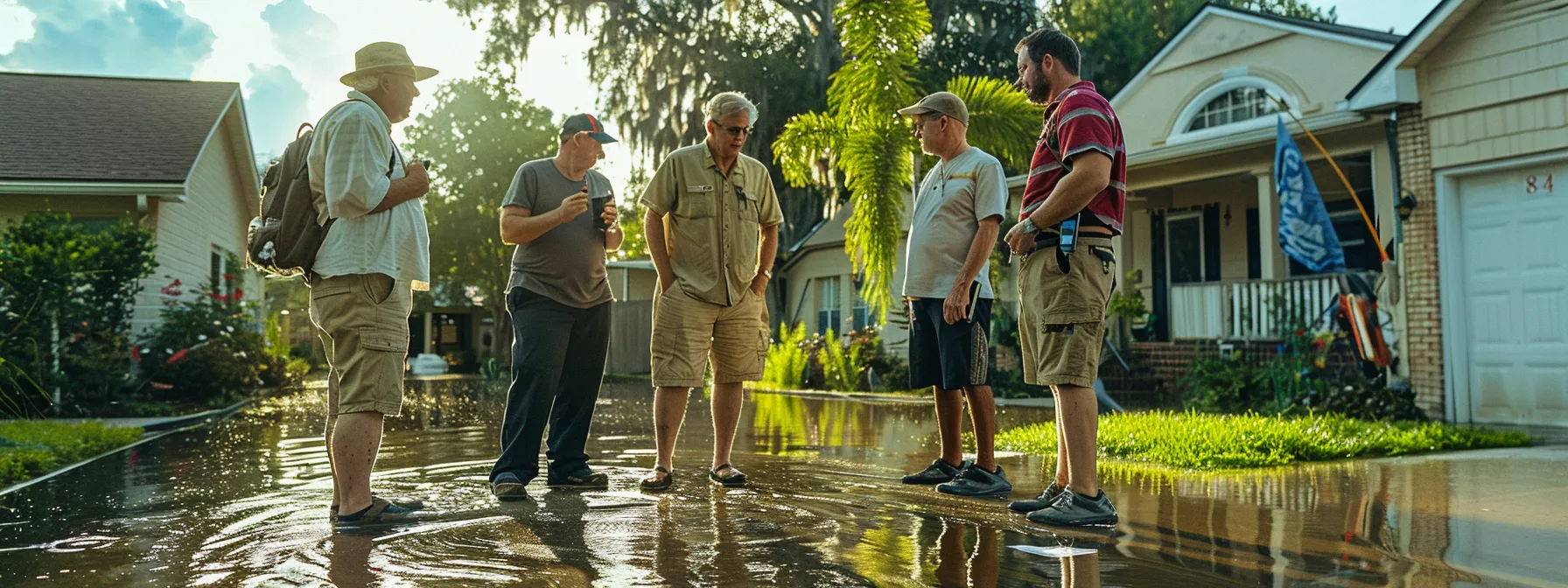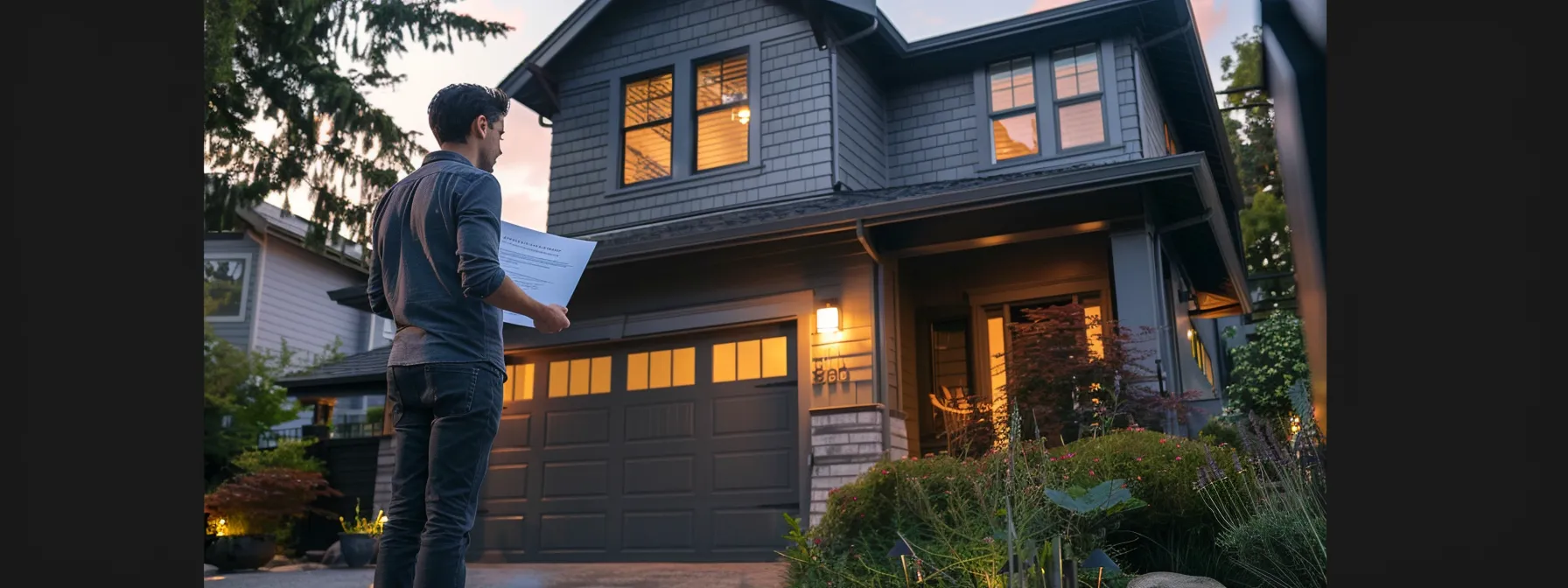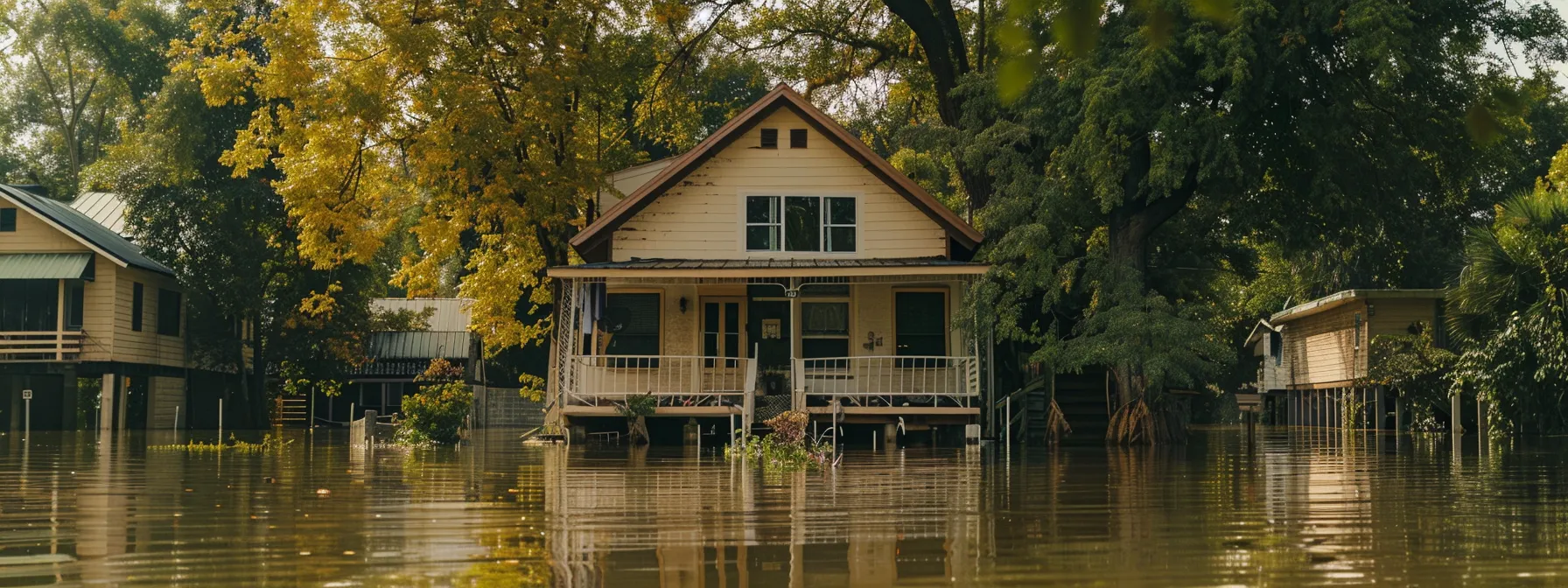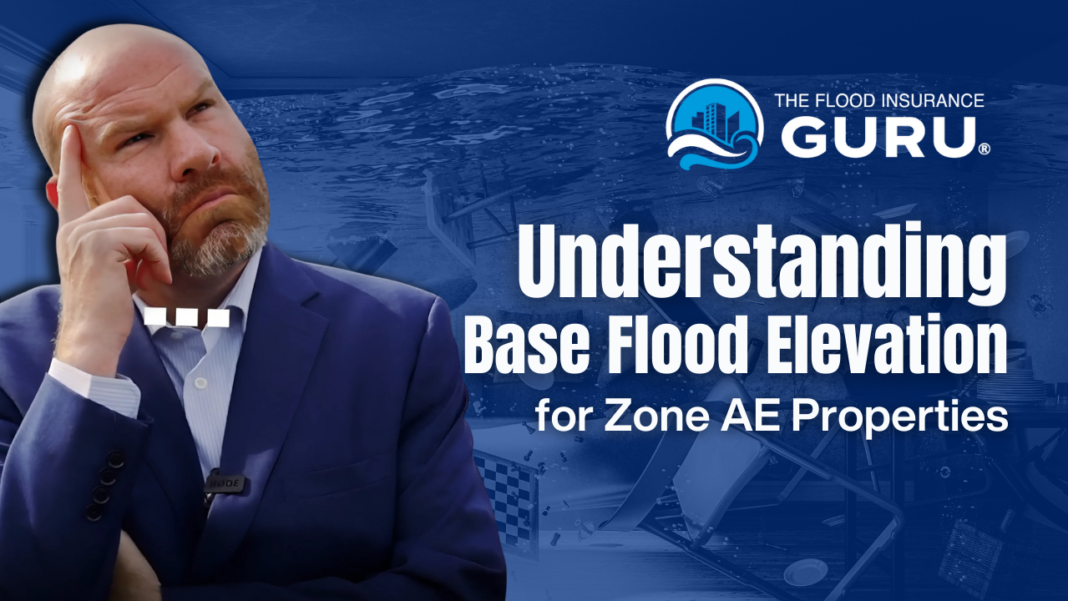As homeowners within Zone AE floodplains, understanding Base Flood Elevation (BFE) is critical for ensuring your property’s safety and managing insurance costs effectively. BFE indicates how high floodwaters could rise during a “base flood,” or a flood that has a one percent chance of occurring in any given year, as determined by the Federal Emergency Management Agency (FEMA).
Navigating the intricacies of BFE not only impacts your home’s accessibility in the event of a flood but also plays a significant role in your flood insurance premiums and compliance with federal regulations.
Keep reading to unearth the methods for determining your property’s BFE in Zone AE and learn how this knowledge can influence your insurance and building requirements. With the right information, you’ll be equipped to make informed decisions that safeguard your home and your finances.
What Is Base Flood Elevation in Zone AE?

Understanding the Base Flood Elevation (BFE) is vital for homeowners like myself living in a Zone AE flood area. As dictated by the National Flood Insurance Program, this measurement represents the expected height water will rise during a base flood. This benchmark is crucial because it affects my home insurance and the regulatory construction standards set for new buildings and restorations. My neighbors and I often discuss how Zone AE differs from other zones, primarily in the mandatory flood insurance requirements and the risk level for floodwaters reaching our properties.
Knowing the BFE allows for a more informed approach to safeguarding our homes against potential flood damage. We constantly turn to the flood insurance rate map for clarity on these elevation figures, knowing it’s not just numbers—it’s about the safety and security of our homes.
Defining Base Flood Elevation Effect on Property
The significance of Base Flood Elevation (BFE) resonates directly with my insurance policy; as a homeowner in a special flood hazard area, the BFE ultimately determines how high floodwaters could rise, thereby informing the coverage I must secure. Calculating risk becomes a precise endeavor, tailoring my flood insurance necessities to the actual threats my property faces.
Undoubtedly, property owners in Zone AE, including myself, are bound by the implications of their area’s BFE—it shapes the very architecture and retrofitting choices we make. Not only does it influence the premiums and conditions of my flood insurance, but it also dictates the measures required to minimize potential flood damage and bolster our homes’ resilience.

Key Differences Between Zone AE and Other Flood Zones
In my journey to understand why Zone AE is distinctive, I’ve learned that properties within this classification have a well-documented risk of flood hazard, a factor that isn’t synonymous with all flood zones. Homeowners with mortgages from federally regulated lenders in Zone AE are mandated to purchase flood insurance, whereas those in non-special hazard areas may not face this requirement. The emphasis lies in navigating the nuanced data provided by flood maps and elevation certificates, which aren’t as pivotal in less risky zones.
The surveying information for Zone AE is far more comprehensive compared to less hazardous zones, where BFE data might not be as readily available or might not even exist. This distinction has direct implications on building codes and insurance premiums, making it essential for us homeowners in high-risk areas to stay current with the most accurate and detailed flood risk information, which informs the protective measures and mortgage requirements for our properties.
HOW TO DETERMINE YOUR PROPERTY’S BFE IN ZONE AE
Accurately pinpointing my property’s Base Flood Elevation within Zone AE is a process that is essential for making informed decisions related to construction, policy, and preventing water damage. To carry out this task, I frequently use FEMA’s Flood Map Service, an online tool where the BFE information is meticulously outlined. These maps assist in concrete decision-making, from the building design adaptations needed to comply with local regulations, to understanding the specifics of my flood insurance and the coverage necessary to safeguard my investment.
Moreover, I make it a point to consult with local authorities who have the expertise to provide precise measurements and the latest updates affecting our zone, thereby ensuring that my building plans and flood readiness measures are as accurate and up-to-date as possible.
Using FEMA’s Flood Map Service to Find BFE Information
Stepping into the role of an informed homeowner, I turn to FEMA’s Flood Map Service Center as a critical resource for emergency management. This interactive tool allows me to locate my property within Zone AE and provides a visual representation of flood hazards relative to sea level. Insights into the height at which floodwaters could rise inform my compliance with local building codes and insurance requirements. For a deeper understanding of what it entails to be in a Flood Zone AE and how it affects properties, it’s worth exploring more detailed resources.
For instance, when considering alterations to my home or addressing local loan stipulations, the clarity of BFE data from FEMA’s maps is indispensable. Not only does it help me adhere to complex regulations, but it also equips me with the knowledge to discuss possible code adjustments with planners and architectural consultants effectively.
|
Resource |
Role in Emergency Management |
Relevance to Building Code & Loan Requirements |
|
FEMA’s Flood Map Service |
Identifies flood hazard in relation to sea level |
Ensures property height compliance |
Consulting With Local Authorities for Accurate Measurements
Navigating the specifics of BFE for my home near a stream or river means engaging with local authorities who understand our community’s unique hydrology. Their expertise in the geographical nuances of our area is invaluable for homeowners like me, as it affects both the safety of our homes and our insurance expenses.
As I live close to the coast, I seek insights from our community experts who possess a wealth of localized knowledge about environmental factors affecting flood risk. Their understanding of dynamic coastal conditions aids in ensuring the measurements used to ascertain my property’s BFE are both current and precise.
THE IMPACT OF BFE ON FLOOD INSURANCE RATES FOR ZONE AE PROPERTIES
In Zone AE, insurers meticulously assess Base Flood Elevation when calculating premiums, correlating the risk of flood damage to potential costs. As a homeowner wary of financial strain, I recognize the importance of BFE in determining the market value of my insurance. Employing this tool aids in predicting the likelihood and impact of a disaster, which directly influences the rates imposed by the Federal Housing Administration (FHA) and other underwriters.
To hedge against these costs, comprehending BFE is indispensable—it empowers me to implement elevation measures that can lead to substantial insurance savings. Factors like adherence to the North American Vertical Datum of 1988 standards for floodplain management have a pronounced effect on the underwriting process, making informed insights into BFE not just beneficial but critical for any property owner within the flood zone’s domain.

How Insurance Providers Use BFE to Calculate Premiums
As soon as coastal flooding becomes a risk for my home, insurance providers take special notice, relying heavily on the BFE document as a foundation for their calculations. They confer with data that engineers have meticulously verified, considering the proximity of my property to potential high water and adjusting their rates accordingly.
When I submit an elevation certificate to my insurer, the marked BFE substantially informs the premium I’m quoted. From their perspective, the higher my home’s lowest floor is above the BFE, the less risk there is – a factor that can significantly lower the cost of insuring against flood damage.
Ways to Reduce Your Flood Insurance Costs by Understanding BFE
Grasping the intricacies of Base Flood Elevation has provided me with opportunities to mitigate my flood insurance expenses. By ensuring my home’s structure is elevated above the determined BFE, I’ve positioned myself not only to safeguard against flooding but also to potentially qualify for lower insurance rates, as my property poses less risk to insurers.
I’ve found that sharing an accurate Elevation Certificate reflecting my home’s compliance with or exceeding local BFE guidelines is a persuasive tool in negotiating reduced premiums. The proactive approach to demonstrating lower risk through elevation adjustments and fortified construction has proven to be a financially wise strategy for weathering the tides of insurance costs.
BUILDING REQUIREMENTS FOR PROPERTIES IN A ZONE AE

Navigating the regulatory standards for new constructions within Zone AE necessitates a keen understanding of mandatory elevations. As I examine the implications for my property, I must consider how these elevations serve as a linchpin for compliance. Grounded in the knowledge that the elevation requirements are more than just guidelines—they’re crucial thresholds that help prevent significant flood damage—I approach these directives with the gravity they deserve.
My focus becomes twofold: ensuring the safety of future developments through adequate building elevation while adhering strictly to established floodplain management policies that govern Zone AE. Acknowledging the weight of these obligations, I prepare to delve into the specifics of mandatory elevations and the critical role they play in achieving compliance.
Navigating Regulatory Standards for New Constructions
Steering the design and construction of a new home in Zone AE requires adherence to specific elevation requirements. These directives, mandated by FEMA, are designed to ensure that the lowest floor of a building is above the anticipated level of floodwaters, mitigating risks and safeguarding the property.
For me, compliance with these elevation standards is indispensable; it ensures that my home is insurable and meets the guidelines that protect our community. Collaborating with architects and builders who are well-versed in these regulations guarantees that my structure won’t just stand, but also endure, in the face of potential flooding.
|
Design Element |
Regulatory Requirement |
Importance to Homeowner |
|
Lowest Floor Elevation |
Above BFE |
Minimizes flood risk, ensures insurability |
|
Builder Expertise |
FEMA Compliant |
Construction integrity and regulatory compliance |
Mandatory Elevations and Their Importance for Compliance
Living in Zone AE amplifies the importance of adhering to mandatory elevation requirements set by FEMA. These elevations are pivotal as they ensure new structures are built to withstand the specific flood conditions of an area, acting as a first line of defense against flood damage. A home’s lowest floor elevation above the BFE is not merely a recommendation but an enforced standard to maintain insurability and mitigate risk.
|
Construction Aspect |
Importance |
Homeowner’s Responsibility |
|
Adherence to Mandatory Elevation |
Prevents flood-related structural damage |
Ensure building plans meet FEMA’s criteria |
|
Obtaining Proper Permits |
Legally validates construction compliance |
Acquire and maintain relevant documentation |
My responsibility as a homeowner extends beyond just owning property; it’s about meeting or exceeding the required elevations to secure the longevity and safety of my home. Acknowledging the criticality of these elevations for compliance has compelled me to validate that the necessary elevation certificates are up to date and that my home aligns with current FEMA floodplain management practices.

THE ROLE OF ELEVATION CERTIFICATES IN ZONE AE

In my quest to proactively manage my flood-prone property in Zone AE, obtaining an Elevation Certificate (EC) has been the cornerstone of my strategy. The EC is instrumental, as it denotes my house’s elevation relative to the BFE, providing a clear snapshot of my potential flood risk. It’s a document I’ve learned to decipher with care, given how it impacts not just insurance rates but also the resilience of my home. With this certificate in hand, I can make a solid case to challenge insurers on excessively high premiums, armed with tangible evidence of my efforts to reduce flood risk at my doorstep.
Getting and Understanding Your Property’s Elevation Certificate
Securing an Elevation Certificate for my property was an informative venture; it involved hiring a land surveyor who documented the elevations of my house’s various floors and its geographical features. This process clarified my home’s vulnerability to flooding by comparing its elevation to the official BFE for Zone AE, enabling a more accurate assessment of my flood insurance needs. For more detailed information, you can explore unveiling flood zone AE.
The Elevation Certificate is more than a piece of paper to me; it’s the quantitative evidence that insurers and local authorities use to gauge my flood risk. Intimately understanding the specifics on this document, from the building diagrams to the elevation data, underpins every decision I make to protect my home against future floods.
|
Document Feature |
Description |
Homeowner’s Use |
|
Elevation Data |
Height comparisons to Base Flood Elevation |
Assesses vulnerability and insurance needs |
|
Building Diagrams |
Visual layouts of house elevations |
Informs safety upgrades and code compliance |
|
Surveyor Certification |
Authentication of the documented elevations |
Provides credibility in discussions with stakeholders |
Leveraging Your EC to Appeal High Insurance Rates
Armed with my Elevation Certificate, I approached my insurance company with a newfound confidence. Presenting the detailed information laid out in the certificate, particularly showing that my home’s lowest floor is above the BFE, I initiated negotiations for more favorable insurance rates, arguing my reduced risk profile.
My persistence paid off after rigorous discussions backed by the Elevation Certificate’s data; the insurer recognized the diminished likelihood of extensive flood damage to my property. This acknowledgment led to a well-deserved decrease in my insurance premiums, aligning the costs with the true level of risk my home presented.

TACKLING THE CHALLENGES OF LIVING IN A HIGH-RISK FLOODING AREA

Living in Zone AE requires me to confront the challenges of high-risk flooding with decisive action and informed choices. The escalating severity and frequency of weather-related events necessitates a proactive stance on flood proofing initiatives that are most effective for properties in this area. I have discovered that integrating techniques such as property elevation and the installation of flood barriers can significantly mitigate potential damage. Additionally, as climate conditions continue to shift, I remain vigilant in staying abreast of the latest safety guidelines and compliance requirements, ensuring that my home adheres to the stringent standards meant to protect it against the changing whims of nature.
Flood Proofing Methods That Work Best for Zone AE
As a homeowner in Zone AE, I’ve implemented several flood proofing methods to protect my property. Elevating my home above the BFE has been a critically effective measure, significantly reducing the risk of floodwater intrusion during surge events.
Moreover, I’ve invested in fortifying my home’s foundation and installing backflow valves in the plumbing system, which are essential practices to prevent water from backing up into my house during a flood. These choices, advised by local floodplain managers, help maintain the integrity of my dwelling during adverse weather conditions.

Maintaining Safety and Compliance Amidst Changing Climate Conditions
Adapting to evolving climate conditions is an ongoing responsibility as a resident of Zone AE. I actively engage with community floodplain management updates to ensure my property remains compliant with the latest safety standards, which are increasingly stringent as weather patterns intensify. My vigilance serves as a protective measure not only for my home but also for the broader community’s wellbeing.
I’ve taken it upon myself to regularly consult updated climate data and projections, translating this information into actionable steps for reinforcing my home’s resilience to flooding. This awareness informs my ongoing participation in community preparedness programs, where collaboration and shared knowledge become key to collectively navigating the challenges posed by a dynamic climate landscape.
CONCLUSION
Understanding Base Flood Elevation (BFE) for properties in Zone AE is critical for mitigating flood risk and ensuring proper insurance coverage. As a homeowner, comprehending and adhering to the BFE can lead to safer building practices and potential savings on flood insurance premiums.
An accurate Elevation Certificate is indispensable, displaying a home’s elevation relative to the BFE and impacting insurance negotiations. Proactive measures, informed by BFE knowledge, fortify homes against flood damage and contribute to community resilience in the face of rising flood events.



